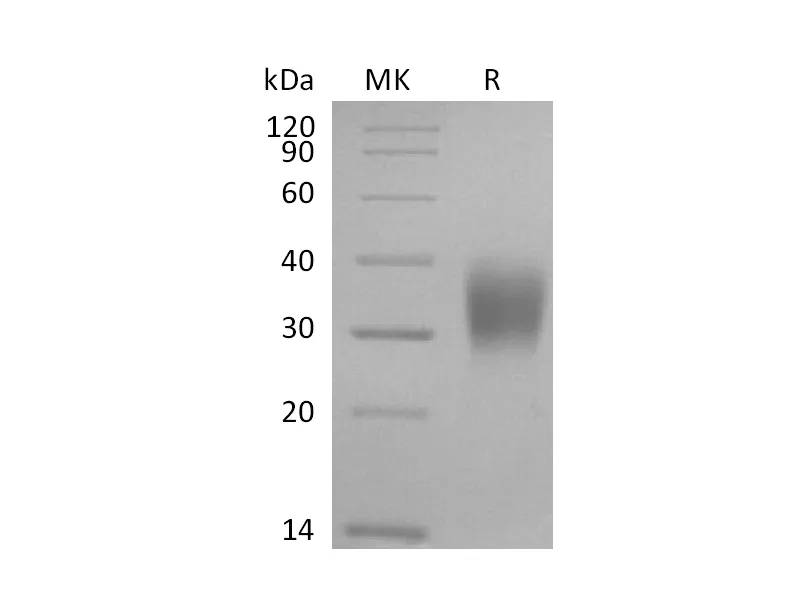
Size2:50μg price2:$378
Size3:500μg price3:$1980
| Name | Recombinant Cynomolgus CD16a (C-6His) |
| Purity | Greater than 95% as determined by reducing SDS-PAGE |
| Endotoxin level | <1 EU/µg as determined by LAL test. |
| Construction | Recombinant Cynomolgus Low Affinity Immunoglobulin Gamma Fc Region Receptor III-A is produced by our Mammalian expression system and the target gene encoding Glu21-Gly206 is expressed with a 6His tag at the C-terminus. |
| Accession # | A0A140HDP8 |
| Host | Human Cells |
| Species | Cynomolgus |
| Predicted Molecular Mass | 22 KDa |
| Buffer | Lyophilized from a 0.2 μm filtered solution of PBS, pH 7.4. |
| Form | Lyophilized |
| Shipping | The product is shipped at ambient temperature.Upon receipt, store it immediately at the temperature listed below. |
| Stability&Storage | Store at ≤-70°C, stable for 6 months after receipt.Store at ≤-70°C, stable for 3 months under sterile conditions after opening. Please minimize freeze-thaw cycles. |
| Reconstitution | Always centrifuge tubes before opening.Do not mix by vortex or pipetting.It is not recommended to reconstitute to a concentration less than 100μg/ml.Dissolve the lyophilized protein in distilled water.Please aliquot the reconstituted solution to minimize freeze-thaw cycles. |
Alternative Names
Low Affinity Immunoglobulin Gamma Fc Region Receptor III-A; CD16a Antigen; Fc-Gamma RIII-Alpha; Fc-Gamma RIII; Fc-gamma RIIIa; FcRIII; FcRIIIa; FcR-10; IgG Fc Receptor III-2; CD16a; FCGR3A; CD16A; FCG3; FCGR3; IGFR3
Background
Receptors for the Fc region of immunoglobin G (FcγR) are divided into three classes and FcγRIII is a multifunctional, low/intermediate affinity receptor. In humans, FcγRIII is expressed as two distinct forms (FcγRIIIA and FcγRIIIB) that are encoded by two different but highly homologous genes in a cell type-specific manner. FcγRIIIB is a low-affinity, GPI-linked receptor expressed by neutrophils and eosinophils, whereas FcγRIIIA is an intermediate affinity polypeptide-anchored transmembrane glycoprotein expressed by a subset of T lymphocytes, natural killer (NK) cells, monocytes, and macrophages. The FcγRIIIA receptor is involved in phagocytosis, secretion of enzymes, inflammatory mediators, antibody-dependent cellular cytotoxicity (ADCC), mast cell degranulation, and clearance of immune complexes. FcγRIIIA has an immunoreceptor tyrosine-based activation motif (ITAM) in its cytoplasmic domain and delivers an activation signal in the immune responses. Aberrant expression or mutations in this gene is implicated in susceptibility to recurrent viral infections, systemic lupus erythematosus, and alloimmune neonatal neutropenia. In humans, it is a 50 -70 kD type I transmembrane activating receptor. The FcγRIIIA cDNA encodes 254 amino acid including a 16aa signal sequence, 191 amino acid ECD with two C2-type Ig-like domains, five potential N-glycosylation sites, a 22 amino acid transmembrane sequence and a 25 amino acid cytoplasmic domain.
Note
For Research Use Only , Not for Diagnostic Use.
